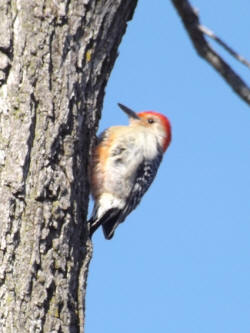 In central Illinois several birds do overwinter, including the
northern cardinal, the black-capped chickadee, red-bellied
woodpecker and the American goldfinch.
In central Illinois several birds do overwinter, including the
northern cardinal, the black-capped chickadee, red-bellied
woodpecker and the American goldfinch.Other birds that may come
in just for the season could include the dark-eyed junco and pine
siskin.
The easiest way to keep a bird in the backyard is to provide it
with a food source. While birds were created to forage the woods and
be self-sufficient, in the common backyard they may not find
everything they need to survive without a little human help.
During the winter months, birds require higher-energy foods to
help them sustain colder temperatures. This type of energy can be
provided through suet. Suet bricks typically are fat products
incorporated with popular seeds. The "brick" can be placed in an
open feeder or in a hanging feeder designed specifically for it.
Suet bells can also be hung from tree limbs.
Another wintertime treat that some varieties of birds will enjoy
is peanut butter. Here is a fun activity you can do with the entire
family:

You will need pine cones, peanut butter, small wild bird feed and
string. Place a cup or so of peanut butter in a microwavable
container and heat until near liquid stage. Dip the bottom half of
the pine cone in the warmed peanut butter and immediately roll in
the small seeds. Set cones on wax paper in a cool location until the
peanut butter sets up once again. Tie a string to the top portion of
the cone and tie it to tree branches in your yard.
As the days turn drab, here are just a few of the winged wonders
you can look for in your backyard:
 Northern cardinal
Northern cardinal
The northern cardinal is one of the most well-liked winter birds.
The males are a striking shade of red, with a reddish bill and black
face. Females are a more subtle light brown, almost golden, with
tinges of red on the wings, tail and crest. Cardinals enjoy all
types of seeds but seem to most enjoy sunflower.
Black-capped chickadee
The black-capped chickadee is a social bird with a natural
curiosity that actually attracts it to humans. It features a black
cap and bib, white cheeks, gray back, wings and tail, and a whitish
underside. Their body shape is small, with a round head that gives
them an overall appearance of being plump little balls of bird.
They fly to the feeder, grab a bite and fly away to eat it
elsewhere. They are also savers that collect seeds and hide them for
future consumption. They have excellent memories, never forgetting
where they've stashed their private store.
These birds enjoy suet in the wintertime along with sunflower
seeds and peanuts. They are also easily drawn to window feeders
because of their sense of curiosity and seeming lack of fear of
humans.
 Red-bellied woodpecker
Red-bellied woodpecker
The red-bellied woodpecker is one of the more flashy birds at the
feeder. With their black-and-white striped backs and red heads, they
are easy to spot, though they don't tend to stay at the feeder for
long periods of time.
An interesting habit of the woodpecker is that it will grab up
large nuts from the feeder, take them to a tree and wedge them into
the bark, then peck the nuts into smaller edible pieces.

In the wintertime they enjoy suet, peanuts and sunflower seeds.
In addition they enjoy fruit such as grapes, oranges and mangoes.